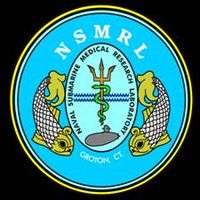Naval Submarine Medical Research Laboratory
| Naval Submarine Medical Research Laboratory | |
|---|---|
 | |
| Active | 1942 |
| Country |
|
| Branch |
|
| Role | NSMRL is the primary source of submarine medicine and safety information for the US Navy. |
| Part of | Naval Medical Research Center (NMRC) |
| Garrison/HQ | New London Submarine BaseGroton, Connecticut |
| Commanders | |
| Current commander | Captain Frederick Yeo |
The Naval Submarine Medical Research Laboratory (NSMRL) is located on the New London Submarine Base in Groton, Connecticut. The laboratory's mission is to protect the health and enhance the performance of United States War Fighters through focused submarine, diving, and surface research solutions.[1][2] It is a subordinate command of the Naval Medical Research Center.[3]
History and overview
The United States Submarine Service has a long and proud tradition of developing and operating with leading edge technologies.[2] The Naval Submarine Medical Research Laboratory is a major contributor to integrating these technologies into submarine crew operations.[2] Established in World War II to conduct mission critical studies in night vision, sonar sound discrimination, and personnel selection, NSMRL continues to serve the fleet by taking the lead in undersea human factors, Sensory analysis, and operational medicine.[1][2]
NSMRL is at the forefront of operational undersea research and development, as it has been for over 50 years. Its achievements include:[1][2]
- Sea Lab 1 habitat project
- Disabled Submarine Escape and Rescue project
- "Rig-for-red" viewing
- Development of the International Orange color (Air-Sea Rescue Red)
- Studies of hyperbaric nitrogen narcosis
- Development of saturation diving and decompression tables
- Performance based screening of color vision
- Personnel screening and assessment for enclosed environments
- Effects of atmospheric constituents on health and performance in enclosed environments
- Underwater acoustic signal discrimination and classification
- Bioeffects of underwater sound
- Search and rescue
NSMRL is located in Groton, Connecticut, near the juncture of the Thames River and Long Island Sound. Arrangements for system validation are conveniently made through Submarine School New London; sea trials with research products are coordinated through the Submarine Base New London and the Naval Undersea Warfare Center in Newport, RI.[1][2]
Facilities
- NSMRL Unique Physical Facilities
- Two Hyperbaric Chambers - Saturation and Hypobaric Capability
- 1000 m3 Anechoic Chamber
- 145 m3 Reverberant Chamber
- Ten Sound proof Audio Testing Booths
- Vision and Auditory Research Suites
- Technical Library & Graphics Studio
- Waterfront Access (Submarines and Diving)
- Diving Work Boat
The NSMRL auditory laboratory includes a large, 1000 m3 Anechoic Chamber.[1][4] The suspended cable floor and fiberglass wedges provide an "echo-free" environment that is essential for efforts on spatialized auditory displays and transducer evaluation. Additionally, there are ten fully instrumented soundproof booths and a reverberant room. These facilities are integral to the work on human-machine interfaces, combat systems displays, hearing conservation, audio signal enhancement, noise reduction techniques, and diver hearing.
The laboratory has a 142 m3 enclosed atmosphere testing environment and facilities for cardiopulmonary and metabolic workload assessment.[1][4] Close collaboration on several projects has been maintained with the Royal Navy of the United Kingdom and its facilities at Alverstoke, England.[1][4]
NSMRL's diving research program is supported by a saturation diving chamber certified to pressures simulating 350 fsw and a fully instrumented hyperbaric treatment chamber.[1][4] Both chambers are capable of supporting multi-diver teams and associated medical, physiological, and exercise equipment.
The laboratory also maintains an enclosed 25-foot Boston Whaler equipped with GPS and radar, to support open water diving research.[1][4]
Library
Many of the NSMRL publications have been scanned and are available online at the Rubicon Research Repository.[5][6] Other articles can be found in the DUMC Archive finding aids of the Undersea and Hyperbaric Medical Society library collection.
See also
References
- 1 2 3 4 5 6 7 8 9 Daniel, JC & Lamb, J (2005). "NSMRL: A Small Command with A Huge Presence for the Submarine Force". US Naval Submarine Medical Research Laboratory Technical Report. NSMRL-TR-1239. Retrieved 2008-07-13.
- 1 2 3 4 5 6 NSMRL. "ABOUT NSMRL -- History and Overview". Archived from the original on September 21, 2007. Retrieved 2008-07-13.
- ↑ "NMRC Subordinate Commands". U.S. Naval Medical Research Center. Retrieved 25 July 2014.
- 1 2 3 4 5 NSMRL. "ABOUT NSMRL -- Facilities". Archived from the original on October 9, 2007. Retrieved 2008-07-13.
- ↑ NSMRL. "NSMRL publications". Archived from the original on September 14, 2007. Retrieved 2008-07-13.
- ↑ Rubicon Foundation. "NSMRL Collection". Retrieved 2008-07-13.
